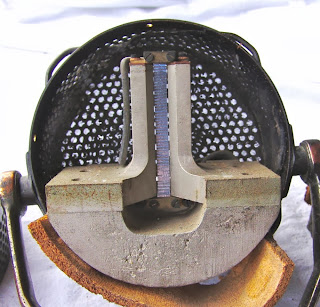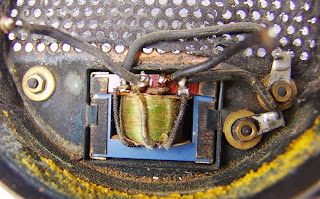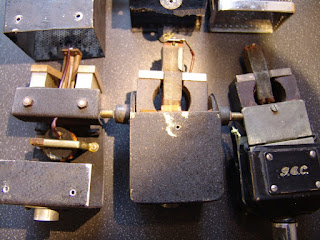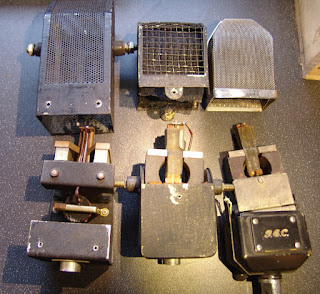Good BBC-Marconi Type-A ribbon microphones are scarce, and perhaps one reason is that too many were decommissioned, mounted and given away as gifts or ornaments, for retirement, achievement and occasionally as trophies.
Tag: BBC
BBC-Marconi Ribbon Microphone Type B
Our microphone of the month for September is this a rare and lovely BBC-Marconi ‘type B’ ribbon microphone. The type B is closely related to the ‘A’ series of mics (AX, AXB and AXBT) which were made from around 1935 onwards. The model B was made from 1937 onwards and used the same motor assembly, but with a smaller (yet still massive) magnet and without the ribbon tension adjustment facility.
 |
| BBC Marconi type B, side view |
The smaller magnet format allowed the mic to be packaged into a smaller cylindrical body, and these were apparently were often used for outside broadcast, attached to the chest of the broadcaster! One would have to be pretty strong to carry that around all day.
Although this is widely know as the model ‘B’, the nameplate calls it 8559A.
 |
| BBC Marconi type B badge |
As well as the outer grill, there are two extra windshields inside the mic, which would have protected the ribbon from wind blasts and dirt. These windshields did their job well – in this example, the ribbon is unbroken, but this has oxidised and stiffened over the years and will need to be replaced.
 |
| BBC Marconi type B ribbon motor |
The magnet and motor assembly are held in place with foam rubber, which has mostly survived the years. The output transformer is hidden behind the magnet. This had a break in the secondary winding, but luckily I was able to unwind it by a single turn and bring the mic back to life.
 |
| BBC Marconi type B, transformer |
At the rear of the mic, connection to the outside world is made by three screw terminals, and square bulge at the bottom shows the location of the transformer.
 |
| BBC-Marconi ribbon mic, rear |
Overall, the mic sounds warm and rich, although the metal can gives it a certain ‘boxy’ sound that instantly defines it as a very old microphone!
There is some more info about the BBC-Marconi ribbon mics at the Coutant and Orbem websites.
Thanks to Tom Barwood
GEC Ribbon Microphone Evolution
Some time ago I posted about GEC models BCS 2370 and 2373, and how they were essentially the same design in different body shapes for different applications.
 |
| Left to right – unknown, unknown. GEC BCS2370 and 2373 mics. All have the same motor. |
Since then I have come across some other ribbon microphones which may be earlier GEC models, prototypes. They are perhaps rather ugly in style, but I find their functional utilitarian style rather charming.
The two unbadged mics share some parts including a twinaxial connector at the base and rubber yoke mounts. The mic on the left is made of folded steel, whereas the one on the right is brass, with a more open grill.
All four mics are essentially the same design inside. The mic on the far left has a smaller transformer and different brand of magnet, but the pole pieces and ribbon assembly are the same. The mic in the middle of the photograph above is identical inside to the known GEC mics – with the same magnet and transformer and crumbling plastic ribbon mounts.
| Drawing from a ribbon mic patent by GEC and Thomas Julian, 1947 |
 |
| Drawing from BBC-Marconi type AX ribbon mic manual. |
BBC R&D reports on ribbon mics
The good old BBC have made many of their research and development reports available through their website, spanning 1944 through 1996.
1945
The Crosley ribbon velocity microphone.
1953
Lustraphone VR53 ribbon microphone
The design of the PGD and PGS ribbon microphones.
The EMI microphone Type 2351E.
Tannoy microphone Type MD. 422.
1956
Design of the PGD and PGS Ribbon microphone Part 2
1958
RCA BK5
1961
Reslo RB
1965
Beyer M160
(Thanks to Santiago Ramos for sending the links.)






